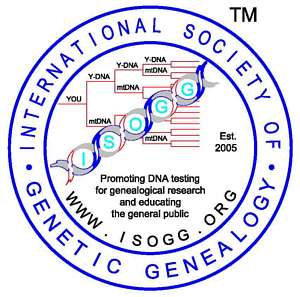Back to Y-DNA Tree Trunk
Back to SNP Index
Back to Papers/Presentations Cited
Back to Glossary Back to Listing Criteria
Copyright 2010 International Society of Genetic Genealogy. All Rights Reserved.

| LINKS: Main Page Y-DNA Tree Trunk SNP Index Papers/Presentations Cited Glossary Listing Criteria |
| CLADE/SUBCLADE SYMBOLS: Added Redefined |
| SNP SYMBOLS: Not on 2009 tree Confirmed within subclade Provisional Private |
B M60, M181, P85, P90
�
B* -
�
B1 M236, M288
� �
B1* -
� �
B1a M146
�
B2 M182
� �
B2* -
� �
B2a M150
� �
�
B2a* -
� �
�
B2a1 M218
� �
� �
B2a1* -
� �
� �
B2a1a M109, M152, P32, P50
� �
�
B2a2 M108.1
� �
� �
B2a2* -
� �
� �
B2a2a M43, P111
� �
B2b M112, M192, 50f2(P)
� �
�
B2b* -
� �
�
B2b1 P6
� �
�
B2b2 M115, M169
� �
�
B2b3 M30, M129
� �
� �
B2b3* -
� �
� �
B2b3a M108.2
� �
�
B2b4 P7
� �
� �
B2b4* -
� �
� �
B2b4a P8, P70
� �
� �
B2b4b MSY2.1, M211
� �
B2c P112
Y-DNA haplogroup B, like Y-DNA haplogroup A, is seen only in Africa and is scattered widely, but thinly across the continent. B is thought to have arisen approximately 50,000 years ago. These haplogroups have higher frequencies among hunter-gather groups in Ethiopia and Sudan, and are also seen among click language-speaking populations. The patchy, widespread distribution of these haplogroups may mean that they are remnants of ancient lineages that once had a much wider range but have been largely displaced by more recent population events.
Some geographic structuring is seen between the sub-groups B2a (B-M150) and B2b (B-M112). Sub-group B2b is seen among Central African Pygmies and South African Khoisan. Sub-group B2a is seen among Cameroonians, East Africans, and among South African Bantu speakers. B2a1a (B-M109) is the most commonly seen sub-group of B2a. About 2.3% of African-Americans belong to haplogroup B - with 1.5% of them belonging to the sub-group B2a1a.
References:
Cruciani et al,
A Back Migration from Asia to Sub-Saharan Africa Is Supported
by High-Resolution Analysis of Human Y-Chromosome Haplotypes.
American Journal of Human Genetics, 70:1197-1214, 2002.
Karafet et al,
New Binary Polymorphisms Reshape and Increase Resolution of the Human Y-Chromosomal Haplogroup
Tree. Abstract. Genome Research, published online April 2, 2008.
Supplementary Material.
Regueiro et al,
Iran: Tricontinental Nexus for Y-Chromosome Driven Migration. (abstract)
Human Heredity, Vol. 61, No 3, 132-143, 2006.
Semino et al,
Ethiopians and Khoisan Share the Deepest Clades of the Human Y-Chromosome Phylogeny. (pdf)
American Journal of Human Genetics, 70:265-268, 2002.
Valone et al,
Y SNP Typing of African-American and Caucasian Samples Using Allele-Specific
Hybridization and Primer Extension. (pdf) Journal of Forensic Science, 49:4, July 2004.
Corrections/Additions made since 1 January 2010:
Contact Person for Haplogroup B: Ana Oquendo Pabon
| Back to Main Page Back to Y-DNA Tree Trunk Back to SNP Index Back to Papers/Presentations Cited Back to Glossary Back to Listing Criteria Copyright 2010 International Society of Genetic Genealogy. All Rights Reserved. |

|